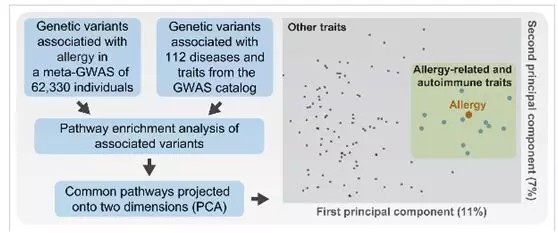JACI:過敏和自身免疫性疾病存在共同基因變異
發(fā)布日期:2019-01-17
原標題:共同的基因變異提示過敏和自身免疫性疾病的共同途徑

延伸閱讀
JACI:
September 2017Volume 140, Issue 3, Pages 771–781
DOI: https://doi.org/10.1016/j.jaci.2016.10.055
Abstract:
Background
The relationship between allergy and autoimmune disorders is complex and poorly understood.
Objective
We sought to investigate commonalities in genetic loci and pathways between allergy and autoimmune diseases to elucidate shared disease mechanisms.
Methods
We meta-analyzed 2 genome-wide association studies on self-reported allergy and sensitization comprising a total of 62,330 subjects. These results were used to calculate enrichment for single nucleotide polymorphisms (SNPs) previously associated with autoimmune diseases. Furthermore, we probed for enrichment within genetic pathways and of transcription factor binding sites and characterized commonalities in variant burden on tissue-specific regulatory sites by calculating the enrichment of allergy SNPs falling in gene regulatory regions in various cells using Encode Roadmap DNase-hypersensitive site data. Finally, we compared the allergy data with those of all known diseases.
Results
Among 290 loci previously associated with 16 autoimmune diseases, we found a significant enrichment of loci also associated with allergy (P = 1.4e-17) encompassing 29 loci at a false discovery rate of less than 0.05. Such enrichment seemed to be a general characteristic for autoimmune diseases. Among the common loci, 48% had the same direction of effect for allergy and autoimmune diseases. Additionally, we observed an enrichment of allergy SNPs falling within immune pathways and regions of chromatin accessible in immune cells that was also represented in patients with autoimmune diseases but not those with other diseases.
Conclusion
We identified shared susceptibility loci and commonalities in pathways between allergy and autoimmune diseases, suggesting shared disease mechanisms. Further studies of these shared genetic mechanisms might help in understanding the complex relationship between these diseases, including the parallel increase in disease prevalence.
All Author:
Eskil Kreiner, MD, PhD?, Johannes Waage, PhD?, Marie Standl, PhD, Susanne Brix, PhD, Tune H. Pers, PhD, Alexessander Couto Alves, PhD, Nicole M. Warrington, PhD, Carla M.T. Tiesler, MSc, Elaine Fuertes, PhD, Lude Franke, PhD, Joel N. Hirschhorn, MD, PhD, Alan James, MD, Angela Simpson, MD, PhD, Joyce Y. Tung, PhD, Gerard H. Koppelman, MD, PhD, Dirkje S. Postma, MD, PhD, Craig E. Pennell, MD, PhD, Marjo-Riitta Jarvelin, MD, Adnan Custovic, MD, PhD, Nicholas Timpson, PhD, Manuel A. Ferreira, PhD, David P. Strachan, MD, John Henderson, MD, David Hinds, PhD, Hans Bisgaard, MD, DMSc'Correspondence information about the author MD, DMSc Hans Bisgaard Email the author MD, DMSc Hans Bisgaard, Klaus B?nnelykke, MD, PhD


——浙大迪迅 譯
①過敏和自身免疫性疾病之間的關(guān)系是復(fù)雜的,了解很少。②我們試圖研究過敏和自身免疫性疾病在基因位點和途徑上的共性,以闡明共同的疾病機制。③我們薈萃分析了兩項全基因組范圍內(nèi)關(guān)于自我報告的過敏和致敏的相關(guān)性研究,共包括62,330名受試者。這些結(jié)果被用來計算與自身免疫性疾病相關(guān)的單核苷酸多態(tài)性(SNPs)的富集。此外,我們還探索了遺傳途徑和轉(zhuǎn)錄因子結(jié)合位點的富集,并利用編碼路線圖DNA -超敏感位點數(shù)據(jù)計算了不同細胞中基因調(diào)控區(qū)域的敏感SNP富集,從而表征了組織特異性調(diào)控位點上不同負擔(dān)的共性。最后,我們將過敏數(shù)據(jù)與所有已知疾病的數(shù)據(jù)進行了比較。④在先前與16種自身免疫性疾病相關(guān)的290個基因座中,我們發(fā)現(xiàn)與過敏相關(guān)的29個基因座(P = 1.4e-17)顯著富集,偽發(fā)現(xiàn)率小于0.05。這種富集似乎是自身免疫性疾病的一個普遍特征。在常見基因座中,48%對過敏和自身免疫性疾病有相同的作用方向。此外,我們還觀察到免疫細胞中染色質(zhì)通路和區(qū)域內(nèi)的敏感SNP富集,這在自身免疫性疾病患者中也有體現(xiàn),但在其他疾病患者中沒有。⑤我們確定了過敏和自身免疫性疾病之間的易感性位點和通路的共性,提示了共同的疾病機制。對這些共同遺傳機制的進一步研究可能有助于理解這些疾病之間的復(fù)雜關(guān)系,包括疾病流行率的平行增加。
延伸閱讀
JACI:
[IF:13.1]
Shared genetic variants suggest common pathways in allergy and autoimmune diseasesSeptember 2017Volume 140, Issue 3, Pages 771–781
DOI: https://doi.org/10.1016/j.jaci.2016.10.055
Abstract:
Background
The relationship between allergy and autoimmune disorders is complex and poorly understood.
Objective
We sought to investigate commonalities in genetic loci and pathways between allergy and autoimmune diseases to elucidate shared disease mechanisms.
Methods
We meta-analyzed 2 genome-wide association studies on self-reported allergy and sensitization comprising a total of 62,330 subjects. These results were used to calculate enrichment for single nucleotide polymorphisms (SNPs) previously associated with autoimmune diseases. Furthermore, we probed for enrichment within genetic pathways and of transcription factor binding sites and characterized commonalities in variant burden on tissue-specific regulatory sites by calculating the enrichment of allergy SNPs falling in gene regulatory regions in various cells using Encode Roadmap DNase-hypersensitive site data. Finally, we compared the allergy data with those of all known diseases.
Results
Among 290 loci previously associated with 16 autoimmune diseases, we found a significant enrichment of loci also associated with allergy (P = 1.4e-17) encompassing 29 loci at a false discovery rate of less than 0.05. Such enrichment seemed to be a general characteristic for autoimmune diseases. Among the common loci, 48% had the same direction of effect for allergy and autoimmune diseases. Additionally, we observed an enrichment of allergy SNPs falling within immune pathways and regions of chromatin accessible in immune cells that was also represented in patients with autoimmune diseases but not those with other diseases.
Conclusion
We identified shared susceptibility loci and commonalities in pathways between allergy and autoimmune diseases, suggesting shared disease mechanisms. Further studies of these shared genetic mechanisms might help in understanding the complex relationship between these diseases, including the parallel increase in disease prevalence.
All Author:
Eskil Kreiner, MD, PhD?, Johannes Waage, PhD?, Marie Standl, PhD, Susanne Brix, PhD, Tune H. Pers, PhD, Alexessander Couto Alves, PhD, Nicole M. Warrington, PhD, Carla M.T. Tiesler, MSc, Elaine Fuertes, PhD, Lude Franke, PhD, Joel N. Hirschhorn, MD, PhD, Alan James, MD, Angela Simpson, MD, PhD, Joyce Y. Tung, PhD, Gerard H. Koppelman, MD, PhD, Dirkje S. Postma, MD, PhD, Craig E. Pennell, MD, PhD, Marjo-Riitta Jarvelin, MD, Adnan Custovic, MD, PhD, Nicholas Timpson, PhD, Manuel A. Ferreira, PhD, David P. Strachan, MD, John Henderson, MD, David Hinds, PhD, Hans Bisgaard, MD, DMSc'Correspondence information about the author MD, DMSc Hans Bisgaard Email the author MD, DMSc Hans Bisgaard, Klaus B?nnelykke, MD, PhD
2019-1-10 Article
創(chuàng)建過敏性疾病的科研、科普知識交流平臺,為過敏患者提供專業(yè)診斷、治療、預(yù)防的共享平臺。

 杭州浙大迪迅生物基因工程有限公司
杭州浙大迪迅生物基因工程有限公司

